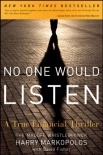No One Would Listen: A True Financial Thriller, Harry Markopolos [graded readers .TXT] 📗

- Author: Harry Markopolos
Book online «No One Would Listen: A True Financial Thriller, Harry Markopolos [graded readers .TXT] 📗». Author Harry Markopolos
Several months later, though, when Frank learned that a Chicago options firm was about to make the same mistake, he called and told them to contact the private eye. They purchased a copy of the original report—and ended negotiations with the trader.
But for Frank, the damage to his relationship with Rampart’s management was irreparable. Who knows if they were more upset that he had brought in this trader or that he had discovered the fraud. It didn’t matter; it was pretty obvious that Frank was on his way out. Frank’s anger was directed almost exclusively at the trader. He decided to leave Rampart before management had a chance to make that decision. It wasn’t a big deal, as few people in the financial industry stay at one firm for their career. It’s a very fluid industry, with tremendous movement, and for Frank it was just time to make his next move.
It was also obvious that I needed to give them a product to replace the trader’s scheme. Rampart and Access were now working together, and both companies needed something to sell. Financial products aren’t like big-screen TVs; you can’t just pull a big one off the shelf and deliver it. Every new financial product has to be tailored specifically to accomplish certain goals to fit a narrow set of market realities. What Rampart needed was a low-risk product that delivered high returns with low volatility.
Who didn’t?
Finally, I accepted the challenge. They wanted me to create an option-based product that returned 1 or 2 percent a month. I’d had a lot of experience running these types of option-sensitive products. It took several months of playing with numbers to fulfill those parameters. Neil, of course, was a major contributor, and I got a lot of data from various major firms. From Citigroup for example, I got the complete S&P 500 price return histories from 1926 to the day I received it. Then I began putting things in, taking things out, testing and retesting and back-testing to see how each package would perform in various market environments.
I did this knowing full well that Bernie hadn’t bothered to do any of this. He just sat down and made it up. It’s considerably easier that way—and you always get the results you want!
Eventually I developed a product we named the Rampart Options Statistical Arbitrage. It was a product that would do extremely well in a market environment with low to moderately high volatility. As long as the market didn’t move more than 8 to 10 percent over a 10- to 15-day trading period, it would perform very well.
Of course, if there was extremely high volatility or if the market did make a substantial move in either direction over that period, it was possible to lose about 50 percent of its value.
To mitigate the risk, we had to be able to transition quickly from short volatility to long volatility to stem our losses, and doing that successfully required having a strategy in place. Whatever the market did, we had to have a prepackaged plan thought out well in advance. For every action the market took we had to have a counteraction already in place, because there would be no time to think when the inevitable occurred.
Obviously, that was impossible because there is an infinite number of things the market can do. So I prepared several basic strategies that would cover as many different scenarios as we could imagine. I tested these scenarios against historical markets going back to 1926. The worst-case scenario for this product was a period from 1929 through the early 1930s, but that was also the worst period for almost everything else in the market. Almost all of the trading plans I developed for these positions were based on market moves in the 1930s, because there was tremendous volatility during that decade. So for several months I was living in the past trying to figure out how to prevent losses in the future.
Admittedly, it wasn’t the greatest financial product ever created on Wall Street. In October 2001, Frank finally left Rampart and moved to New Jersey, where he began selling a fund called Benchmark Plus. By this time we had become good friends and stayed in close contact. In his new job he continued digging up Madoff material. When I created this product he thought he might be able to find some investors, so I went down to see him. He read the prospectus and said correctly, “Harry, this is horseshit. Basically, what you’re saying is you have to wake up on the right side of the bed and make every right move to protect your ass because you could lose everything. Who’s gonna buy this?”
“They wanted something, and I had to give it to them,” I said, not at all defensively. I knew what it was.
What I did not know was that I had made one slight mistake in my math. Unfortunately, I discovered that mistake at the worst possible time.
Rampart and Access initially raised about $6 million. Firms were sort of testing the product, to see how it would perform in actual market conditions before making any substantial investment. For several months it did quite well, but then volatility started getting very low so options lost value. It got kind of rocky. Then we had one month where there was some extremely high volatility. I had a plan in place for that situation, and I successfully traded out of the market. Neil and I were feeling pretty good about it—it was working even better than we had anticipated. I began thinking, Well, maybe this is a product we really can push.





Comments (0)